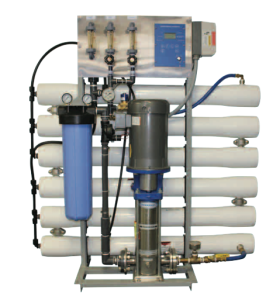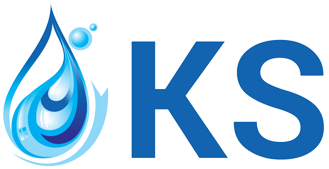Solely focused on the process of water purification through Reverse Osmosis in Toronto, KS Water Treatment stands experienced as an industry expert. We have carried out many projects, in and around Toronto, involving applications of Industrial and Commercial Reverse Osmosis Systems in many settings in the industry. Among the list of clients we have served over the years are Automotive Component Manufacturers, Food & Beverage Production Facilities, Coolant Producers, Greenhouses, Hospitals, Retirement Residences, Semiconductor Manufacturers, Schools and Coffee Shops.
 Reverse Osmosis is simply the process of osmosis in reverse. Typically, osmosis occurs over a semi-permeable membrane in the direction of low solute concentration to high solute concentration. Osmosis refers to the movement of water over a membrane selectively permeable to water. The membrane achieves this property by being composed of a rolled up cellulose sheet of very fine pores. These pores are so small that the only molecule permeable to them is pure water, H2O. Now, the process of Reverse Osmosis simply is osmosis that occurs backwards. In this case, water is forced from a high solute concentration to a low solute concentration through a semi-permeable cellulose membrane. This is accomplished with significant pressure. In the case of Water Reverse Osmosis, either a local booster pump or the city supplies this pressure.
Reverse Osmosis is simply the process of osmosis in reverse. Typically, osmosis occurs over a semi-permeable membrane in the direction of low solute concentration to high solute concentration. Osmosis refers to the movement of water over a membrane selectively permeable to water. The membrane achieves this property by being composed of a rolled up cellulose sheet of very fine pores. These pores are so small that the only molecule permeable to them is pure water, H2O. Now, the process of Reverse Osmosis simply is osmosis that occurs backwards. In this case, water is forced from a high solute concentration to a low solute concentration through a semi-permeable cellulose membrane. This is accomplished with significant pressure. In the case of Water Reverse Osmosis, either a local booster pump or the city supplies this pressure.
 Residentially, especially in Toronto, Reverse Osmosis is used primarily as drinking water. Many customers use this purified, clean water as drinking or cooking water. Residential Reverse Osmosis Systems are composed of 3 distinct parts: a single piece manifold, a 4-gallon storage tank and a chrome-plated faucet. While the manifold and storage tank are installed beneath the kitchen sink, the fancy faucet resides beside the existing kitchen faucet. The manifold is the major component of a 4 or 5-stage Residential Reverse Osmosis System. This is where the 4 or 5 housings are held in place. Every Reverse Osmosis System has both pre and post carbon filters, as well as sediment filters, in addition to the actual Reverse Osmosis Membrane.
Residentially, especially in Toronto, Reverse Osmosis is used primarily as drinking water. Many customers use this purified, clean water as drinking or cooking water. Residential Reverse Osmosis Systems are composed of 3 distinct parts: a single piece manifold, a 4-gallon storage tank and a chrome-plated faucet. While the manifold and storage tank are installed beneath the kitchen sink, the fancy faucet resides beside the existing kitchen faucet. The manifold is the major component of a 4 or 5-stage Residential Reverse Osmosis System. This is where the 4 or 5 housings are held in place. Every Reverse Osmosis System has both pre and post carbon filters, as well as sediment filters, in addition to the actual Reverse Osmosis Membrane.
Granted there are many other industry techniques utilized to purify water, Reverse Osmosis reigns supreme for a variety of reasons. First, it is the most cost-effective over the long run. Relative to a distiller of comparable capacity, an Industrial Reverse Osmosis System will cut costs by about 75%. A second advantage of Reverse Osmosis is that it is a relatively eco-friendly technology and doesn’t involve the use of potentially hazardous chemicals such as Sodium Hydroxide or Hydrochloric Acid, such as Deionization Systems do. Finally, Commercial and Industrial Reverse Osmosis Systems are relatively low-maintenance. Apart from pre-treatment maintenance, the only other component requiring regular service is the Reverse Osmosis membranes.
